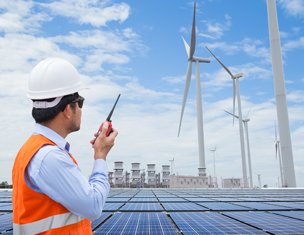Energy Transformation and Climate Change Research

Greenhouse gases (GHGs), including carbon dioxide, are warming the planet because of their heat-trapping characteristics. The warming and changing of the climate are leading to more heat waves, increased flooding, more wildfires and more destructive storms. These changes are negatively impacting the environment and public health.
Human activity is responsible for almost all of the increase in GHGs over the last 150 years. The primary sources are from burning fossil fuels for transportation, electricity and industrial production, and commercial and residential activities.
The United States and other countries are working to reduce GHG emissions globally and transition to the production and use of more sustainable energy sources. To support this effort, research is under way to better understand how new technologies in energy production and transportation will impact overall GHG emissions, the environment, and public health. The research is providing EPA, states, tribes and communities with scientific information and resources to project future emissions from energy sources and to develop and implement strategies for meeting GHG reduction goals. At the same time, research is being conducted to ensure that the benefits of a more sustainable energy system are distributed equitably and improve the lives of all Americans.
On this page:
- Modeling Research for Energy System Transformation
- Environmental Impacts Research
- Research on Potential Impacts of Net-Zero Electricity Generation
- Research to Support the Report to Congress on Biofuels
- Related Resources
- Publications
Modeling Research for Energy System Transformation
Modeling tools are being advanced to assist with developing new strategies to reach GHG Emissions reduction goals in the energy system in the United States.
The research goals are to:
- Evaluate cost and environmental effectiveness of energy-related processes and emission reduction options for the electric power, industrial, commercial, residential, and transportation sectors.
- Improve understanding of how energy storage options and characteristics will affect the energy system and environmental impacts.
- Evaluate the potential for emerging low-carbon energy technologies and zero emissions vehicles.
- Improve capabilities to incorporate energy efficiency and changes in energy use.
- Inform estimates of the carbon footprints of tribal-nations, states and other regions as well as carbon intensity estimates for major manufacturing industries, commodities and their supply chains.
COMET (City-based Optimization Model for Energy Technologies) - COMET is an energy-environment-economic optimization model. COMET is designed to capture the whole energy system at the city level for a user-defined analyses timeline, from the introduction of the energy sources to conversion into useful energy to meet end-use energy service demands.
GLIMPSE Model - GLIMPSE is a decision support modeling tool being developed by EPA that will assist states with energy and environmental planning through the year 2050. Users of GLIMPSE can explore the impacts of energy technologies and policies on the environment. For example, GLIMPSE can examine measures that promote energy efficiency, estimating the resulting energy savings, analyzing how emissions and air quality would be affected, and reporting how energy-related water use would change. Additional technologies that could be analyzed include electric and hydrogen fuel cell vehicles, wind and solar power, and carbon capture and sequestration.
Environmental Impacts Research
Research is helping to improve understanding of the beneficial and negative environmental impacts of transitioning to a low-carbon energy system under climate change.
The research goals are to:
- Quantify the life-cycle implications of these scenarios for domestic manufacturing activity, energy, water, emissions, and waste disposal.
- Quantify other major benefits and unintended consequences of energy system transition scenarios.
- Evaluate the environmental justice and economic justice implications of these scenarios.
Research on Potential Impacts of Net-Zero Electricity Generation
Information is being conducted to improve understanding of how the transition to a decarbonized system of electricity generation will affect EPA’s ability to maintain and improve public health and environmental quality. Net zero electricity generation is when the amount of greenhouse gas produced is no more than the amount removed from the atmosphere.
The research goals are to:
- Develop an assessment of different scenarios to achieve net zero electricity generation by 2035, along with the anticipated positive and negative environmental implications of those scenarios.
- Explore localized impacts of grid decarbonization and provide assessments on how it would impact resilience of and economic burden to communities.
- Develop and/or identify tools to evaluate public health and environmental impacts of grid decarbonization.
Research to Support the Report to Congress on Biofuels
Scientific information is being developed to inform development of the latest Report to Congress on Biofuels. The Report is designed to inform decision makers about the observed and potential environmental and natural resource impacts of the Renewable Fuel Standard, which is focused on biofuel production and use.
Related Resources
- EPA's Climate Change Homepage
- Greenhouse Gas Emissions and Removals
- Generate: The Game of Energy Choices for students
